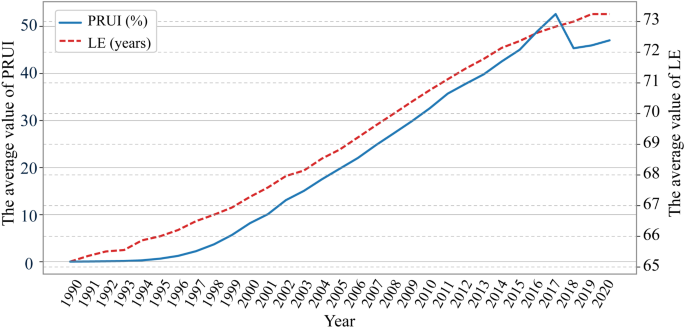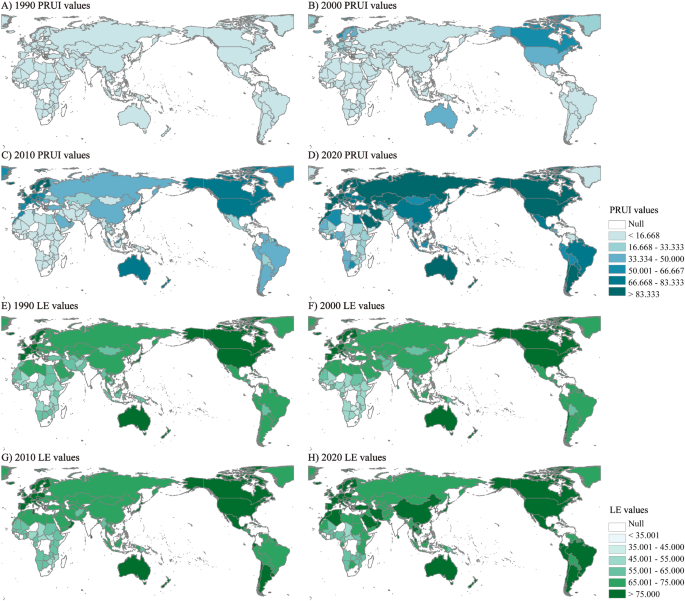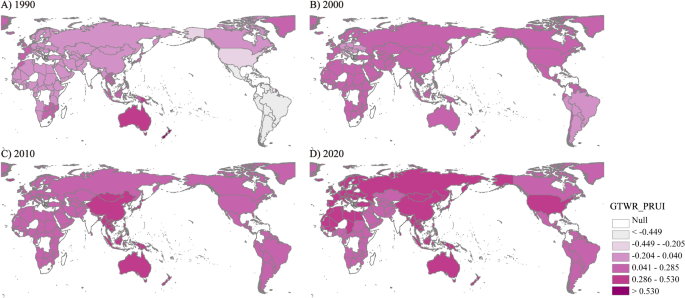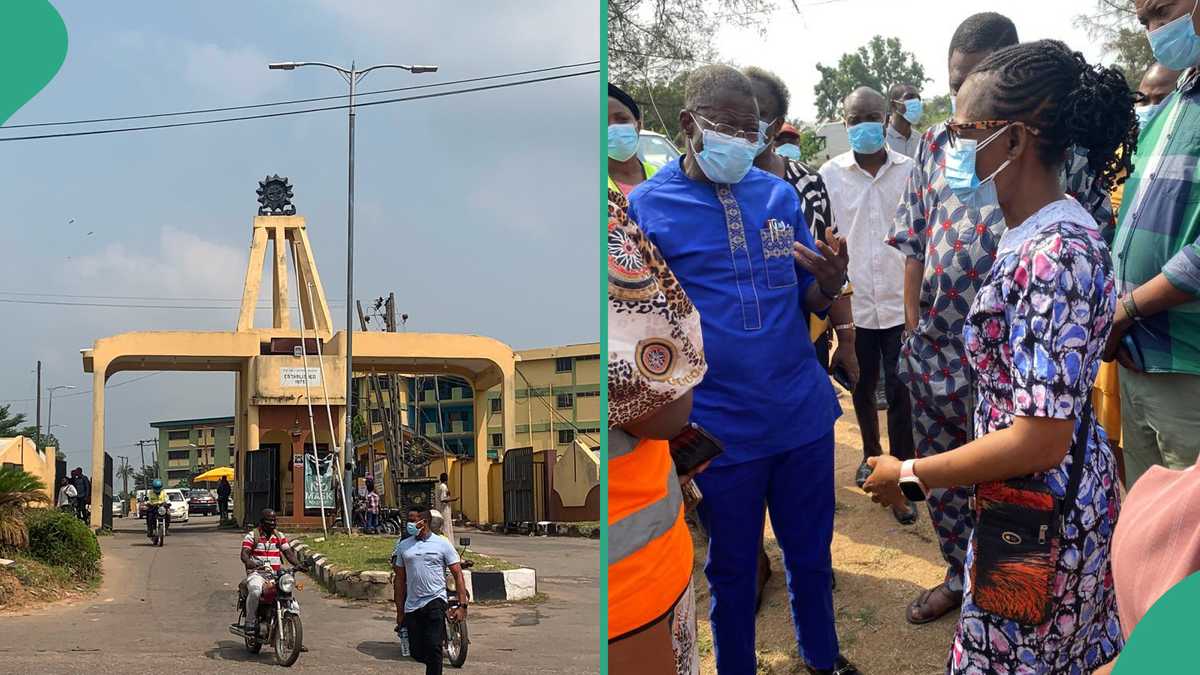BMC Public Health volume 25, Article number: 569 (2025) Cite this article
Internet use has become an important factor affecting health. The spatio-temporal heterogeneity of the influence of internet utilization on life expectancy has not been thoroughly investigated on a global scale. The spatial clustering patterns that influence of internet usage on residents’ health levels have not yet been detected. The Geographically and Temporally Weighted Regression (GTWR) model is used to examine the spatio-temporal variation of the associations between internet use and life expectancy in 182 countries from 1990 to 2020. K-mean is employed to reveal the spatial clustering patterns exhibited by GTWR fitting coefficients. The results demonstrate that internet use significantly and positively impacts life expectancy globally based on GTWR fitting coefficients. Meanwhile, the influence of internet use on life expectancy demonstrates spatio-temporal heterogeneity and non-stationarity. Furthermore, six distinctive spatial clusters are revealed utilizing the GTWR fitting coefficients as a foundation. Spatial cluster 1 is the region where internet use has the least health-promoting effect, whereas spatial cluster 6 is the region where internet use has the greatest health-promoting effect. Our findings offer novel insights into the spatio-temporal heterogeneity relationship and non-stationarity between internet use and life expectancy while providing empirical evidence to support the implementation of region-specific internet policies aimed at enhancing health outcomes.
Information and Communication Technology (ICT) is regarded as one of the essential elements in promoting residential health. The promotion of public health through digital technology can be theoretically supported by multiple frameworks, including the Health Belief Model (HBM) and Social Cognitive Theory (SCT). The HBM posits that individuals’ health behaviors are influenced by their perceptions of health risks and benefits, which digital tools can enhance by providing timely health information and personalized feedback [1]. SCT also underscores the role of digital technologies in promoting health by enhancing self-efficacy and facilitating social support networks [2]. Digital health platforms such as social media, telemedicine, and online health communities provide users with a support system and access to resources, enabling them to adopt healthier behaviors [3]. Extensive empirical studies focused on the influence of ICT and digital technology on the health level of residents.
For example, ICT can spread health knowledge and medical information to residents, which is beneficial for improving health levels [4, 5]. Some studies also suggest that applying digital and smart healthcare will improve patients’ health status and subjective well-being and reduce medical costs [6]. ICT access can also promote social communication and significantly affect residents’ quality of life [7]. The World Health Organization (WHO) has released the Global Strategy for Digital Health (2020–2025), which proposes utilizing ICT to carry out medical services, health security activities, improvement of lifestyles, etc., thereby improving the residents’ health level [8].
In addition, ICT, particularly internet use, contributes to achieving better health status for vulnerable groups. For instance, the internet can help the elderly search for health-related information, promote social interaction, reduce social isolation, and promote physical and mental health [9, 10], as well as provide pregnant women with prenatal health knowledge to ensure the safety of their fetuses [11]. Furthermore, the role of the internet popularity in emergencies has become increasingly prominent. Individuals can take classes online, search for different types of information, implement telehealth, and maintain contact with the outside world during the outbreak of COVID-19 [12, 13]. The progress of ICT, specifically the improvement in the internet access rate, can potentially decrease mortality rates even more by fostering advancements in science and technology, education, healthcare services, urban development, and societal openness [14].
Furthermore, numerous research has indicated that the utilization of ICT, particularly internet usage, positively impacts human well-being at the regional level. For instance, an empirical study adopts internet and phone penetration as proxy variables of ICT, indicating that ICT can reduce population mortality in China based on provincial panel data [15]. Another research has evaluated the impact of the application of ICT on the self-assessed health of individuals in China [16, 17]. A regional study suggests that the prevalence of internet utilization may contribute to an increase in life expectancy and a decrease in infant and under-five mortality rates in Sub-Saharan Africa [12, 18]. Other documents have found that digital technology, internet use, and mobile cellular subscriptions can also elevate life expectancy in low-income countries and BRICS countries [19, 20]. A cross-country study is to investigate the influence of ICT on the physical health outcomes of nations covering 185 countries during 2005–2018. The results indicate heterogeneity in the impact of internet usage and mobile phone usage on LE and mortality rates in low-income and high-income countries [21]. Additionally, an empirical study utilizing panel data from 185 countries reveals that when ICT development surpasses a certain threshold, further investment in digital technology may begin to negatively impact public health [21]. Recent studies have explored the various ways in which excessive internet use can negatively influence health outcomes. In particular, prolonged exposure to digital screens and online environments has been associated with adverse physical and mental health effects [22]. Internet addiction can lead to psychological impacts, such as depression and anxiety, especially among younger users who spend extensive time online [23].
In sum, prior studies have explored the relationship between ICT, particularly internet use, and health indicators based on regional or individual survey data. However, two gaps can be found in existing studies. First, early studies employed Ordinary Least Squares (OLS) regression to establish the relationship between ICT and life expectancy [24]. As more longitudinal data became available, researchers have utilized panel data models, including fixed-effects and random-effects models, to explore the relationship between ICT and health in different regions [25]. There are spatial differences in internet usage across countries in the digital age, and few scholars have discussed the spatial and temporal heterogeneity of the influence of internet use on residential health across countries. Second, the spatial cluster patterns of internet use’s influence on residential health are not widely recognized globally.
Therefore, we collected panel data from 182 countries during 1990 to 2020 to achieve the following aims: (1) A theoretical framework for promoting life expectancy through internet use is constructed based on the HBM and SCT. (2) We evaluate the impact of internet utilization on health from the perspective of spatial and temporal variations using the GTWR model. (3) Further, this study aims to identify the evolution of clustering patterns by using the K-means clustering method. This research can offer scientific recommendations for promoting the sustainable advancement of regional digital health in the era of digitization.
Explained variable
Previous studies have universally adopted Life expectancy at birth (LE), Under-5 mortality (U5-M), Maternal mortality ratio, and Self-rated Health to measure the residents’ health level [26, 27]. LE serves as a comprehensive gauge of the overall health condition of a country and is extensively employed as a fundamental metric for tracking the advancement of national welfare concerning the Sustainable Development Goal (SDG) by the United Nations [28]. In this study, we have applied the LE to measure the residential health levels.
Core explaining variable
Numerous documents have applied secure internet servers, optical cable mileage, and the quantity of domain names as proxy variables for ICT [29, 30]. In the internet use-related fields, some researchers have also focused on the population ratio of internet use as proxy variables for explaining the development of digital techniques or ICT at the regional level [31, 32]. This research aims to test whether internet utilization has promoted individuals’ health levels; therefore, we also selected the population ratio using the internet (PRUI) as the core explaining variable.
Instrumental variable
There has been a significant increase in attention to endogeneity complications in empirical work [33]. Instrumental variable analysis is utilized to address the influence of confounders that cannot be directly measured [34, 35], which can effectively solve the endogenous problem. Therefore, the selection of instrumental variables needs to be related to endogenous explanatory variables and not related to error terms [36]. Therefore, this study selects mobile cellular subscriptions (MCS), a key driver of internet usage penetration, as the instrumental variable to investigate the relationship between PRUI and LE.
Control variables
Higher levels of economic development typically lead to improve health outcomes and longevity [37]. Human capital, such as education levels, plays a critical role in shaping health outcomes by influencing health literacy and the ability to adopt healthy behavior [38]. Countries with higher health spending typically have better healthcare systems, which contribute to improved life expectancy [39]. Environmental factors, such as air quality, significantly impact health outcomes. Poor air quality increases the risk of respiratory and cardiovascular diseases, reducing life expectancy [40]. Urbanization influences health and life expectancy through improved access to healthcare, education, and economic opportunities, but it can also introduce challenges like pollution and congestion, controlling for urbanization accounts for these complex effects [41]. Social development, including employment situation, is a broader societal determinant that significantly influences health outcomes and life expectancy [42]. Population density affects health outcomes through factors like the spread of infectious diseases, access to public services, and the living environment [43]. Moreover, gender ratio is an important demographic variable, as gender differences in health behaviors, access to healthcare, and biological factors can influence life expectancy. Controlling for gender ratio ensures demographic balance in the analysis. In this study, GDP per capita (GDPpc), school enrollment ratio, tertiary (SET), current health expenditure per capita (CHEpc), population ratio exposed to PM2.5 (PREpm2.5), urban population rate (UPR), unemployment ratio (UR), Sex ratio (SR), Population density (PD) are used as proxy variables for them.
The collected data included sufficient data from 182 countries and regions and covered the period 1990–2020, so we have a panel dataset as shown in Table 1. The data employed in this research are obtained from the World Bank, World Development Indicators (WDIs)(https://data.worldbank.org/indicator). Specifically, the origin of the data for LE is from the United Nations Population Division World Population Prospect: 2022 Revision. The data sources of PRUI and MCS are from the International Telecommunication Union (ITU) World Telecommunication/ ICT Indicators Database. The data source of GDPpc is derived from World Bank national accounts data and OECD National Accounts data files. The data source of SET is from the UNESCO Institute for Statistics (UIS). The data source of CHEpc is from the WHO Global Health Expenditure database. PREpm2.5 is from the Global Burden of Disease Study. UPR data source is from the United Nations Population Division, World Urbanization Prospects. UR data source is from the International Labour Organization. SR data is from the UN, World Population Prospects (2024). PD data is derived from the Food and Agriculture Organization and World Bank population estimates.
Global spatial autocorrelation
Global spatial autocorrelation is commonly employed for assessing the overall extent of spatial clustering for attribute variables [44]. In this paper, global spatial autocorrelation is quantified by the value of I which can be computed as follows [45,46,47]:
$$\:I=\frac{n\times\:\sum\:_{i}^{n}\sum\:_{j}^{n}{w}_{ij}({x}_{i}-\stackrel{-}{x})({x}_{j}-\stackrel{-}{x})}{\sum\:_{i}^{n}\sum\:_{j}^{n}{w}_{ij}\times\:\sum\:_{i}^{n}{({x}_{i}-\stackrel{-}{x})}^{2}}$$
(1)
$$\:{w}_{ij}=\left\{\begin{array}{ll}1,&\:\text{if}{\:\:\:\:d}_{ij}\le\:{d}_{\text{threshold}}\\\:0,&\:\text{if}\text{}{d}_{ij}>{d}_{\text{threshold}}\end{array}\right.$$
(2)
In Eq. (1), n represents the number of regional units; x denotes the LE value of the ith country. In Eq. (2), wij is the weight element, \(\:{d}_{ij}\) represents the distance between spatial units i and j, and \(\:{d}_{\text{threshold}}\) is the predefined distance threshold that determines whether the points are considered neighbors. Additionally, Moran’s I values are assessed using Z-scores, which can be computed in the following manner:
$$\:Z=\frac{I-\text{E}\left(I\right)}{\sqrt{Var\left(I\right)}}$$
(3)
In Eq. (3), E(I) is the expectations of Moran’s I. Moran’s I variance is denoted as Var(I). The range of Moran’s I values spans from − 1 to 1. Positive values (close to + 1) indicate positive spatial autocorrelation, where similar values (high or low) tend to cluster together in geographic space. Values near 0 indicate no significant spatial autocorrelation, suggesting a random spatial distribution of the data. Negative values (close to -1) indicate negative spatial autocorrelation, where dissimilar values are located near each other (e.g., high values are surrounded by low values, and vice versa) [45]. In addition, the expectation value of global Moran’s I under the null hypothesis where no spatial correlation is slightly less than zero.
Geographically and temporally weighted regression
GTWR model simultaneously considers the non-stationarity of time and space, elevating it to a further extension of the conventional Geographically Weighted Regression (GWR). GTWR captures the evolving relationship between variables in spatial-temporal contexts, yielding regression results that closely align with reality compared to GWR [48]. Consequently, the GTWR model fulfills spatio-temporal data analysis requirements and enhances our understanding of spatio-temporal heterogeneity across space and time [49]. The GTWR has the following key assumptions: (1) the relationships between dependent and independent variables vary across space and time, (2) the bandwidth used in spatio-temporal weight matrix is optimally selected to balance bias and variance, avoiding overfitting, (3) the model assumes that within each localized region and time, the relationship between variables remains stable [50]. So, this paper employs the GTWR model to investigate the spatio-temporal heterogeneity as follows:
$$\:{y}_{i}{=\beta\:}_{0}\left({u}_{i},{v}_{i},{t}_{i}\right)+{\sum\:}_{j=1}^{n}{\beta\:}_{j}\left({u}_{i},{v}_{i},{t}_{i}\right){x}_{ij}+{\epsilon\:}_{i}$$
(4)
In Eq. (4), yi is the observed value, i.e., LE in this paper. (ui, vi, ti) is the spatiotemporal coordinates of the ith sample unit, \(\:{\beta\:}_{0}\left({u}_{i},{v}_{i},{t}_{i}\right)\) is the constant term for regression, \(\:{\beta\:}_{j}\left({u}_{i},{v}_{i},{t}_{i}\right)\) represents the regression coefficient for the jth variable of the ith observation spatial unit. When this coefficient is significantly positive, it indicates that internet use has a significant positive impact on life expectancy in this study [51]. n is the total number of variables, xij denotes the value of the jth independent variable at the ith observation spatial unit, and εi is a random error term obeying N (0, δ2) distribution. The estimation of regression coefficient at the observation spatial unit i (national scale in this study) can be calculated based on the method of locally weighted least squares [52]:
$$\:{\beta\:}_{j}\left({u}_{i},{v}_{i},{t}_{i}\right)={\left[{X}^{T}W\right({u}_{i},{v}_{i},{t}_{i}\left)X\right]}^{-1}{X}^{T}W({u}_{i},{v}_{i},{t}_{i})Y$$
(5)
$$\:{W}_{\left({u}_{i},{v}_{i},{t}_{i}\right)}=diag\left({W}_{i1},{W}_{i2},\dots\:\dots\:,{W}_{in}\right)$$
(6)
$$\:\begin{array}{c}{W}_{ij}=exp\left\{-\left[\frac{\left[\right({u}_{i}-{u}_{j}{)}^{2}+({v}_{i}-{v}_{j}{)}^{2}]}{{h}_{S}^{2}}+\frac{({t}_{i}-{t}_{j}{)}^{2}}{{h}_{T}^{2}}\right]\right\}\\\:=exp\left\{-\left[\frac{({d}_{ij}^{S}{)}^{2}}{{h}_{S}^{2}}+\frac{({d}_{ij}^{T}{)}^{2}}{{h}_{T}^{2}}\right]\right\}\\\:=exp[-\frac{({d}_{ij}^{S}{)}^{2}}{{h}_{S}^{2}}]\times\:exp[-\frac{({d}_{ij}^{T}{)}^{2}}{{h}_{T}^{2}}]\\\:={W}_{ij}^{S}\times\:{W}_{ij}^{T}\end{array}$$
(7)
In Eq. (5), X represents the vector of influencing factors, W(ui, vi, ti) refers to a diagonal matrix of n-dimensional spatio-temporal distance weights. In Eq. (7), we used a Gaussian kernel function to construct the weight matrix [53]. \(\:{W}_{ij}^{S}\) and \(\:{W}_{ij}^{T}\) represent spatial weight and temporal weights, respectively. \(\:({d}_{ij}^{S}{)}^{2}\)=\(\:({u}_{i}-{u}_{j}{)}^{2}+({v}_{i}-{v}_{j}{)}^{2}\) is defined as Euclidean distance, and \(\:({d}_{ij}^{T}{)}^{2}\) is defined as time distance. \(\:{h}_{s}\:\)and \(\:{h}_{t}\) are regarded as space bandwidth and time bandwidth [49]. The value of \(\:{h}_{s}\:\)and \(\:{h}_{t}\) can be determined by the cross-validation (CV) method or corrected Akaike Information Criterion (AICc). We adopt AICc to calculate the value of \(\:{h}_{s}\:\)and \(\:{h}_{t}\) due to its higher precision [54]. The equation can be expressed as follows:
$$\:\text{A}\text{I}\text{C}\text{c}=nln\left({\sigma\:}^{2}\right)+n+\frac{2k(n+k)}{n-k-1}$$
(8)
In Eq. (8), n is the number of observations, k is the number of parameters in the model. \(\:{\sigma\:}^{2}=\frac{1}{n}\sum\:_{i=1}^{n}{\left({y}_{i}-{\widehat{y}}_{i}\right)}^{2}\:\)is the estimated residual variance. \(\:{y}_{i}\)is the observed value, and \(\:{\widehat{y}}_{i}\) is the predicted value.
We used the variance inflation factor (VIF) to check for multicollinearity [55]. In this study, we employ the Ordinary Least Squares (OLS), GWR, and GTWR models to examine the potential influence of internet use on LE across countries worldwide. The analysis was conducted using GTWR Add-ins within ArcGIS software (version 10.8). The comparison between the three models is based on criteria such as AICc and R2.
K-means clustering
The K-means algorithm is an uncomplicated iterative clustering technique [56], where a data point is allocated to a cluster by minimizing the squared distance between each data point and the average value of all data points in that particular cluster [57]. The objective is to minimize data variation within clusters and maximize it between different clusters [58]. The study employs K-means clustering to explore spatial clusters based on the GTWR fitting coefficients.
The elbow and silhouette coefficient methods are used to ascertain the most suitable quantity of clusters. The primary concept behind the elbow method involves evaluating the total sum of squared errors (SSE). There will be a gradual reduction in SSE as the value of k for clustering increases. Therefore, the optimal number of clusters can be determined by identifying the k value that corresponds to the inflection point where SEE stabilizes [56, 59]. The proximity of the Silhouette value to 1 suggests a strong association between the entity and the cluster, leading to a more plausible outcome in terms of classification [56, 59, 60]. In addition, the Kruskal-Wallis test is a statistical test that evaluates the distinctions between three or more groups sampled independently without making any assumptions about their distribution [61]. The higher the H value, the greater the difference between groups, which means that the clustering may capture the actual structure in the data. Further, if the P value is less than 0.05, it can be considered that at least one group is significantly different from the other groups, which can explain the rationality of the number of clusters we selected [62].
From 1990 to 2020, PRUI increases from 0.028 to 47.044%, with an average annual increase of 1.517%. Meanwhile, LE ascends from 65.175 to 73.244, with an average annual growth rate of 0.260 years (Fig. 1). The value of PRUI has experienced some minor fluctuations within a small range after 2017. From 2017 to 2018, the downward trend in PRUI can largely be attributed to the internet control measures implemented by various countries in 2017, aimed at regulating online activity, suppressing dissent, and addressing security concerns. Overall, the PRUI and LE both exhibit an upward trajectory yearly.
In ArcGIS 10.8, we employed the equal-interval breakpoint method to classify the PRUI and LE values over a 31-year period for the study area. Subsequently, we visualized the spatiotemporal variations in PRUI and LE at the national level for the years 1990, 2000, 2010, and 2020 based on the 31-year breakpoints (Fig. 2A-H). There are clear variations in spatial-temporal characteristics across the globe. The countries and regions with consistently low PRUI values are primarily located in some African and Asian countries such as Mozambique, Malawi, South Sudan, Cambodia, Tajikistan, Turkmenistan, Iraq, and Yemen. However, the PRUI values in Europe, North America, Oceania, South America, and other Asian and African countries such as Gabon, Ghana, Gambia, Bahrain, Brunei, China, and Cyprus have been increasing from 1990 to 2020 (Fig. 2A-D).
For the explained variable LE, countries with consistently low and rising LE values can exhibit a similar spatial distribution with PRUI globally (Fig. 2E-H). It is worth noting that, unlike other regions, countries such as Cyprus, Japan, and Singapore in Asia, Canada, Costa Rica, and the United States of America in North America, Australia and New Zealand in Oceania, and many European countries consistently have high LE.
This research introduces the instrumental variable (IV) technique through a two-stage least squares (2SLS) estimation to minimize endogenous bias and assess the causal effect of internet usage on health outcomes. Based on previous research [12, 14], we introduce MCS as an instrumental variable. The first-stage estimates consistently show a significant positive correlation between the IV and internet use (Table 2). The second-stage results indicate a significant positive impact of IV on LE. Regarding the correlation between the IV and the endogenous variable (internet use), the F-statistics are all greater than 10, which validates its suitability as an effective instrumental variable. IV test confirms a significant positive effect of internet use on LE.
Before establishing the GTWR model, we need to exclude variables with severe multicollinearity. VIF for all independent variables is less than 10 (Table 3), indicating weak multicollinearity. We also test the spatial autocorrelation of the residuals of linear model (OLS). Table 4 lists the Moran’s I value of the OLS model residuals. The Moran’s I is significantly positive in all years, which suggests that OLS model fails to capture the spatial dependency and a spatio-temporal model is needed to better explain the data.
Moreover, the GTWR model is applied to understand the spatio-temporal influence of PRUI on LE. The performance of the GTWR model is assessed by comparing it with the OLS and GWR models. The values of R2 and AICc are applied to examine the model goodness of fit. In Table 5, control variables are not included in (1). After adding control variables in (2), it has been observed that the outcomes exhibit a higher level of explanatory power evidenced by the significantly elevated R2 value and reduced AICc score. Namely, the R2 value increases from 0.292 in the OLS model and 0.575 in the GWR model to 0.626 in the GTWR model, and the AICc value is reduced from 48604.674 to 45840.500 in the OLS and GWR models, respectively, to 45232.700 in the GTWR model, which demonstrates that the GTWR model exhibits a higher level of fitting accuracy compared to both the OLS and GWR models. GTWR possesses a distinct advantage in comprehending the spatiotemporal non-stationarity of the influence of internet usage on LE. In Supplementary Table 1, we further show the parameters set when running the GTWR model in order to provide more sufficient evidence for the use of the GTWR model in this study.
Prior to analyzing the spatiotemporal heterogeneity in the impact of PRUI on LE, the spatial variability of PRUI’s effect on LE is assessed using the GWR model framework (Supplementary Table 2). Building on this, the GTWR model was employed to capture the temporal dynamics, producing notable coefficients that reflect substantial variations in the spatiotemporal relationship. To provide a concise summary, Table 6 presents six statistical metrics derived from the GTWR model: minimum value (min), average value (avg), maximum value (max), median (med), lower quartile (lq), and upper quartile (uq). The average value can serve as a representation of the average effect of impacting factors, while the maximum and minimum values indicate the extent of variation in regression coefficients. In addition, the dispersion of the regression coefficients is indicated by the lq and uq. PRUI fitting coefficients in Table 6 is regarded as the influence degree of internet utilization on LE.
GTWR is employed to detect the spatio-temporal relations of PRUI and LE. In ArcGIS 10.8, we employed the equal-interval breakpoint method to classify the PRUI fitting coefficients of the GTWR model over a 31-year period for the study area. Subsequently, we visualized the PRUI fitting coefficients for the years 1990, 2000, 2010, and 2020 based on the 31-year breakpoints (Fig. 3A-D). Overall, significant spatial-temporal variations were observed in the PRUI fitting coefficients, indicating distinct spatial heterogeneity and non-stationarity in the impact of PRUI on LE.
In detail, a rising trend in the effect of internet use on life expectancy can be observed across numerous countries and regions, notably in most African, Asian, European, North American, and South American nations, along with some Oceanian countries such as American Samoa, Kiribati, Tonga, and Samoa. This suggests a growing positive effect of internet use on life expectancy across these areas. Additionally, we found that PRUI fit coefficients remain consistently high in certain Asian countries (e.g., Brunei, Japan, Singapore, and Macao S.A.R.), European countries (e.g., Spain, France, the United Kingdom, and the Netherlands), and Oceanian countries (e.g., Australia, New Caledonia, Nauru, and New Zealand), indicating marked spatial heterogeneity in contrast to other regions.
Furthermore, we constructed box plots and kernel density curves for the GTWR-based PRUI fitted coefficients in 1990, 2000, 2010, and 2020 (Fig. 4). The results indicate an overall upward trend in PRUI coefficients over this period, with a more pronounced increase after 2010. The box plots show that the median values have increased annually, and the number of outliers has decreased, primarily clustering on the positive side. The kernel density plots further reveal that the distribution of PRUI coefficients has shifted from being widely dispersed in 1990 to becoming more concentrated, with a rightward shift in the peak by 2020, indicating a significant increase in the number of countries with high PRUI coefficients. These findings suggest that the global urbanization process has made substantial progress over the past three decades, but disparities in development across regions still persist.
The K-means algorithm is utilized to categorize various countries into distinct clusters based on the PRUI fitting coefficient of GTWR and then to visualize clustering patterns. The elbow method identifies the optimal number of clusters K as the point where the reduction in the Sum of Squared Errors (SEE) slows significantly. In general, the K value corresponding to the maximum contour coefficient (close to 1) is the optimal number of clusters. However, due to the complexity of the data, the silhouette coefficient curve often fluctuates and produces multiple peaks. The K value corresponding to the peak value can also be used as the selection criteria for the number of clusters. Supplementary Fig. 1A indicates that SEE stabilizes when K = 6, while Supplementary Fig. 1B shows that the silhouette coefficient reaches a secondary peak at K = 6. These findings indicate that the clustering effect and quality reach their optimum when K = 6. Furthermore, the H value obtained from the Kruskal-Wallis test is significantly larger than zero, and the P value is below 0.01 (Supplementary Table 3), which implies that the clustering result exhibits substantial distributional disparities, thereby affirming the robustness of the clustering outcomes.
As shown in Fig. 5A, Cluster 1 is mainly concentrated in South America and North America.
Cluster 2 is mainly distributed in certain countries in Africa and Asia, as well as a few European countries (e.g., Ukraine, Moldova, and Romania). Cluster 3 is predominantly located in most European countries, some African countries, and two countries in North America (the United States of America and Greenland). Cluster 4 is primarily located in a small number of countries in Asia and Europe. Cluster 5 is mainly distributed in some countries in Asia and Oceania. Cluster 6 is exclusively located in Oceania. In particular, Fig. 5B presents the bar chart illustrating the mean values for each cluster, where the mean values represent the strength of the correlation between PRUI and LE. The results reveal significant differences in GTWR coefficients across the clusters, highlighting the spatial heterogeneity of the impact of PRUI on LE.
The impact of ICT, particularly internet usage, on health status has aroused widespread concern driven by digital health. However, there is limited understanding regarding the global-scale variations in the relationship between internet usage and health status, particularly concerning spatio-temporal heterogeneity and non-stationarity. Our research is one of the initial studies that examine the spatial-temporal heterogeneity and non-stationarity in the relationship between internet use and LE through a cross-national investigation, while also identifying spatial clusters associated with this relationship. The country is divided into six clusters where differentiated internet infrastructure construction policies should be implemented to improve health levels.
Prior researches have the most extensively studied the influence of internet utilization on health status based on regional studies [12, 14, 18, 20] and individual research [9, 13]. For example, internet use can positively and significantly prolong LE, decreasing infant and under-five mortality in sub-Saharan Africa based on generalized quantile regression [12]. The same result is also inferred from a document based on 30 selected Asian countries from 2000 to 2016: the ICT index(derived from secure servers, internet users, and fixed broadband subscriptions) can reduce infant mortality [18]. An empirical study from China also demonstrates that internet use significantly and positively impacts LE; namely, a 1% increase in internet use will be expected to improve LE by 3.9% in the long run [63]. Meanwhile, prior research has investigated the impact of internet usage on health levels at regional scales, such as in China, Malaysia, the United States, and Asia etc [64,65,66]. Namely, the internet has the potential to enhance healthcare services and foster effective communication between patients and healthcare systems, thereby enhancing the overall quality of health [67]. More detailed studies have concluded that the evolution of the internet can decrease mortality rates by promoting openness, education, and advancements in technological innovation and by boosting public healthcare expenditure [15]. In our study, internet use is significantly and positively associated with LE utilizing nationwide panel data spanning from 1990 to 2020 when controlling covariates such as economic development, human capital, health expenditure, air quality, urbanization, social development, sex ratio, and population density. Moreover, internet use has played an increasingly significant role in improving LE from 1990 to 2020. With the widespread adoption of the internet from 1990 to 2020, the public has easier access to health information, which helps reduce disease risk and extend life expectancy [68]. The internet has made telemedicine and e-health services increasingly feasible, allowing people to access online medical consultations, electronic health records, and remote monitoring services. This convenience and accessibility directly enhance the quality of healthcare services and the effectiveness of health management [69]. Moreover, the development of the internet has promoted economic and educational advancement, and higher levels of education and living standards are often associated with better health outcomes [70]. Our discovery aligns with prior research indicating that the utilization of the internet yields advantageous outcomes in terms of enhancing LE.
Additionally, limited research has been conducted on the variations in the effects of internet usage on life expectancy from a spatio-temporal standpoint. For instance, a previous study examines countries with varying income levels to explore potential disparities in how ICT influences human development [21]. The primary results indicate that the ICT index, specifically internet usage, has a noteworthy and favorable influence on human development (measured with the human development index, HDI) solely for countries classified as upper-middle-income, which points out that there exists heterogeneity of the internet use on LE between different income levels [71]. Moreover, another study examines the relationship between internet use as an ICT proxy and health outcomes, demonstrating that the different impact of internet usage on LE is prominent among low and high-income countries, to be specific, which will be expected to increase 36 days of LE in low-income countries. In comparison, only increase 14 days of LE in high-income countries [21]. All the aforementioned research has concluded that the impact of internet usage on health differs across income countries, as indicated by regional investigations. However, there has been limited research conducted to assess the impact of internet usage on global health from spatio-temporal perspectives. Meanwhile, spatial-temporal heterogeneity and non-stationarity of the association of internet usage with health outcomes is largely unexplored at the global scale. Considering the differences in the development stage of digital technology, particularly internet use and LE in different countries, it is essential to determine the spatio-temporal heterogeneity and non-stationarity of the association between internet use and health level. Our main findings indicate that the impact of internet usage on life expectancy exhibits spatio-temporal heterogeneity and non-stationarity, as revealed by the GTWR model.
It is worth noting that, the positive impact of internet use on life expectancy worldwide becomes particularly significant during the COVID-19 pandemic in 2020 [72]. The possible reasons are as follows. During the pandemic, the internet serves as a crucial channel for accessing health information. People can quickly learn about preventive measures and vaccination updates. This rapid dissemination of information helps reduce infection risks and may positively impact life expectancy. Despite the pandemic restricting travel for many people, especially the elderly and those with chronic illnesses, the internet enables the widespread adoption of telemedicine and online consultations. Through the internet, patients can access professional medical advice and manage chronic diseases. This convenient healthcare service contributes to improving health levels to some extent [6]. The loneliness and stress brought by the pandemic pose challenges to mental health, and the internet provides channels for social and psychological support. Many people maintain social connections through video calls and social media, alleviating loneliness and reducing mental health risks. During home isolation in the pandemic, the internet serves as an important source for people to obtain advice on healthy lifestyles, including home workouts and nutritional guidance. It helps reduce health risks associated with unhealthy behaviors [12]. This study conducts a 30-year long-term spatiotemporal impact analysis. The impact of COVID-19 on life expectancy and the influencing mechanisms of the internet in this context require further in-depth analysis in future research.
Furthermore, existing research lacks spatial clustering exploration of the correlation between internet usage and individuals’ health. Spatial clustering is extensively employed to conduct spatial feature analysis of LE. For instance, spatial clusters ascertain the spatial distribution of LE between urban and rural areas in Bangladesh [73]. Multiple studies have only utilized the spatial cluster to evaluate the LE cluster characteristics in Europe [74], Indonesia [57], and Greece [75]. It is worth noting that our study further displays the spatial cluster feather of associations between LE and PRUI factors based on the fitting coefficient of GTWR. The core finding indicates that the positive influence degree of internet use on LE can be ranked as Cluster 6 > Cluster 5 > Cluster 4 > Cluster 3 > Cluster 2 > Cluster 1. The entire global region has been divided into six different spatial clustering units based on the impact degree of internet usage on LE, which further reveals the spatial heterogeneity and non-stationarity of internet use impact on LE on a spatial scale. In Cluster 2(Africa and Asia), the internet usage rate is lower, and its health-promoting effects are smaller. In Cluster 6(Oceania), the internet usage rate is high, and the health benefits are also the greatest. However, in Cluster 1(South America and North America) and Cluster 3(Europea), the internet usage rate is higher, but the health benefits are small. We can infer that the impact of internet use on health levels may exhibit nonlinear characteristics [21]. Moreover, numerous researches have evidenced that there is a spatial spillover effect of ICT on air quality, foreign trade, and the development of the economy [15, 76, 77]. We could infer that internet usage has positive spatial spillover effects on health based on previous research and the results of this study.
Our research strongly suggests that it is necessary to regard ICT as a lever to promote human health. Meanwhile, digital health governance is not only a matter for one country but also involves regional cooperation strategies according to spatial clustering results. Specific digital health promotion policies need to be implemented in different regions considering spatial-temporal heterogeneity and non-stationarity. The health levels of countries in South America and North America (Cluster 1), certain countries in Africa and Asia (Cluster 2), as well as European countries (Cluster 3), benefit less from the promotive effects of internet use. Strengthening the construction of health-friendly digital infrastructure in these countries could involve several key strategies. Improve access to reliable internet connections, particularly in underserved or rural areas, to ensure equitable digital access. Establish comprehensive and interoperable health information systems that integrate data from various sources, including electronic medical records, public health databases, and wearable devices. Provide training and resources to improve digital health literacy among populations, enabling them to access, interpret, and use health-related information effectively. Specifically, in regions with lower levels of health, it is imperative to establish standardized internet policies and guarantee the availability and reachability of electronic gadgets like smartphones and personal computers [12].
The “Global Strategy for Digital Health (2020–2025)” aims to improve the health of populations worldwide by accelerating the development and adoption of appropriate, accessible, affordable, scalable, and sustainable people-centered digital health solutions. Our study provides strategies for the global promotion and implementation of digital health. In regions with low internet usage, efforts should focus on building digital infrastructure. In regions with high internet usage, it is important to consider the principle of diminishing marginal returns for digital technologies and to conduct real-time monitoring of the health promotion effectiveness of digital infrastructure. These measures can effectively enhance the health of residents in these regions.
Several limitations should also be noticed. First, our findings primarily rely on global country-level data instead of local scales such as provincial or city levels. Therefore, more in-depth and detailed research should be conducted based on a finer spatial scale. Second, there are multiple factors affecting LE. Our study only considers economic development, human capital, health expenditure, air quality, urbanization, social development, sex ratio, and population density, ignoring genetics, lifestyle factors such as diet, physical activity, smoking, and alcohol consumption, due to the limitation of data resources, which may lead to residual confounding [78,79,80]. The selection of indicators for healthcare development levels should take into account comparability and scientific validity. In this study, we mainly investigate spatial-temporal heterogeneity and non-stationarity, as well as clustering of the association of internet usage and health status on a global scale. In future research, we aim to explore the spatial diffusion and spillover effects of ICT development on health. Moreover, this study analyzes the linear impact of internet usage on life expectancy using GTWR model, however, the non-linear impact between them should be further explored in future research. Future research should consider utilizing methods like the Spatial Lag Model or a Bayesian STVC model to enhance the robustness of the analysis. Finally, K-means clustering has limitations in handling time-series coefficients. Hence, more precise methods should be introduced for spatial clustering analysis in further studies.
This research examines the spatio-temporal heterogeneity and non-stationarity of the influence of internet usage on life expectancy from 1990 to 2020 on a global scale. The main conclusions could be drawn as follows. First, the GTWR model performs better than traditional OLS and GWR models. Globally, the utilization of the internet has shown a notable positive correlation with LE, and this positive effect has continued to increase from 1990 to 2020. Second, spatial heterogeneity of the influence of utilizing the internet on health status exhibits an initial increase followed by a subsequent decrease from 1990 to 2020. Third, k-means clustering analysis demonstrates that there is spatial agglomeration and non-stationarity of the influence degree of internet usage on life expectancy. Finally, countries around the world should establish a global alliance for digital health based on geographical divisions, with ICT as a strategic means to promote residents’ healthy development. Our research focuses solely on the linear characteristics of the impact of internet usage on life expectancy. In future studies, we will further explore the nonlinear characteristics of this impact, aiming to reveal health promotion mechanisms across different geographical regions and countries with varying income levels. This will support the precise formulation of relevant policies in the digital health domain.
The data used in this study can be obtained free on the internet, and the data sources have been given in the content. https://data.worldbank.org/indicator.
- CHEpc:
-
Current health expenditure per capita
- GDPpc:
-
GDP per capita
- GTWR:
-
Geographically and Temporally Weighted Regression
- GWR:
-
Geographically Weighted Regression
- ICT:
-
Information and Communication Technology
- LE:
-
Life expectancy at birth
- OLS:
-
Ordinary Least Squares
- PREpm2.5:
-
Population ratio exposed to PM2.5
- PRUI:
-
Population ratio using the internet
- MCS:
-
Mobile cellular subscriptions
- SDG:
-
Sustainable Development Goal
- SET:
-
School enrollment, tertiary
- U5-M:
-
Under-5 mortality
- UPR:
-
Urban population rate
- UR:
-
Unemployment ratio
- SR:
-
Sex ratio
- PD:
-
Population density
- VIF:
-
Variance inflation factor
We extend our sincere gratitude to Assistant Researcher He Yufeng from Jiangxi Normal University for his invaluable guidance on the methodology. Additionally, we are deeply appreciative of Associate Professor Huang Rui from Nanjing Normal University for her meticulous revisions and improvements to the article’s grammar.
This study was supported by the National Natural Science Foundation of China (No. 42377462, 52108042), Chongqing Social Science Planning Project (Grant No. 2020QNGL39), Chongqing Education Science Planning Project (Grant No. 2020-DP-02), Chongqing Education Commission Humanities and Social Sciences Research Project (Grant No. 22SKGH219).
There is no submission that has data collected from individual participation or samples of human subjects. This study does not include information that could potentially identify an individual. In the manuscript, there is no submission that has data collected from such subjects mentioned above that requires consent or ethics approval.
Not applicable.
The authors declare no competing interests.
Springer Nature remains neutral with regard to jurisdictional claims in published maps and institutional affiliations.
Open Access This article is licensed under a Creative Commons Attribution-NonCommercial-NoDerivatives 4.0 International License, which permits any non-commercial use, sharing, distribution and reproduction in any medium or format, as long as you give appropriate credit to the original author(s) and the source, provide a link to the Creative Commons licence, and indicate if you modified the licensed material. You do not have permission under this licence to share adapted material derived from this article or parts of it. The images or other third party material in this article are included in the article’s Creative Commons licence, unless indicated otherwise in a credit line to the material. If material is not included in the article’s Creative Commons licence and your intended use is not permitted by statutory regulation or exceeds the permitted use, you will need to obtain permission directly from the copyright holder. To view a copy of this licence, visit http://creativecommons.org/licenses/by-nc-nd/4.0/.
Pu, H., Kang, W., Gao, W. et al. Spatiotemporal effect of internet use on life expectancy: cross-country insight from a geographically and temporally weighted analysis. BMC Public Health 25, 569 (2025). https://doi.org/10.1186/s12889-025-21760-1


















